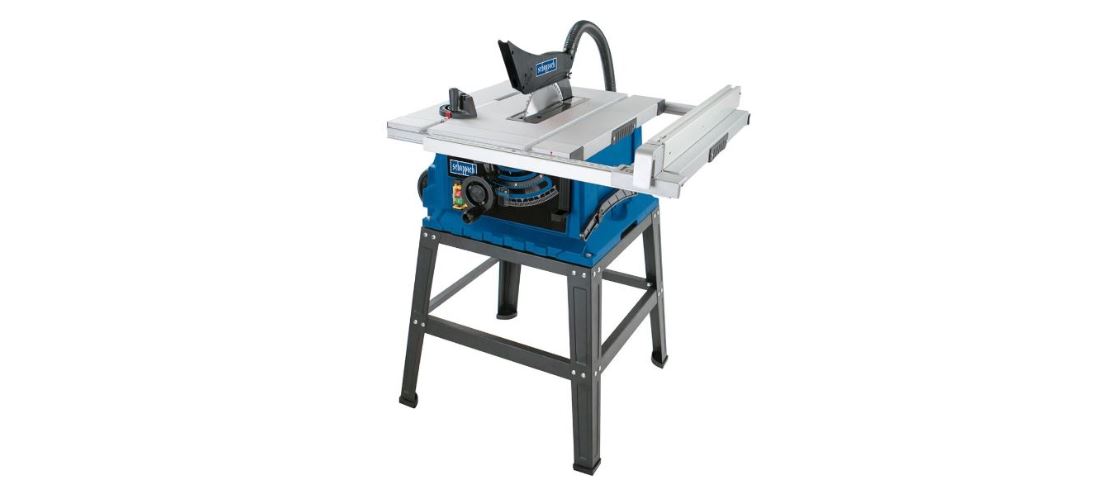scheppach HS105 230V 255mm Electric Table Saw Instruction Manual
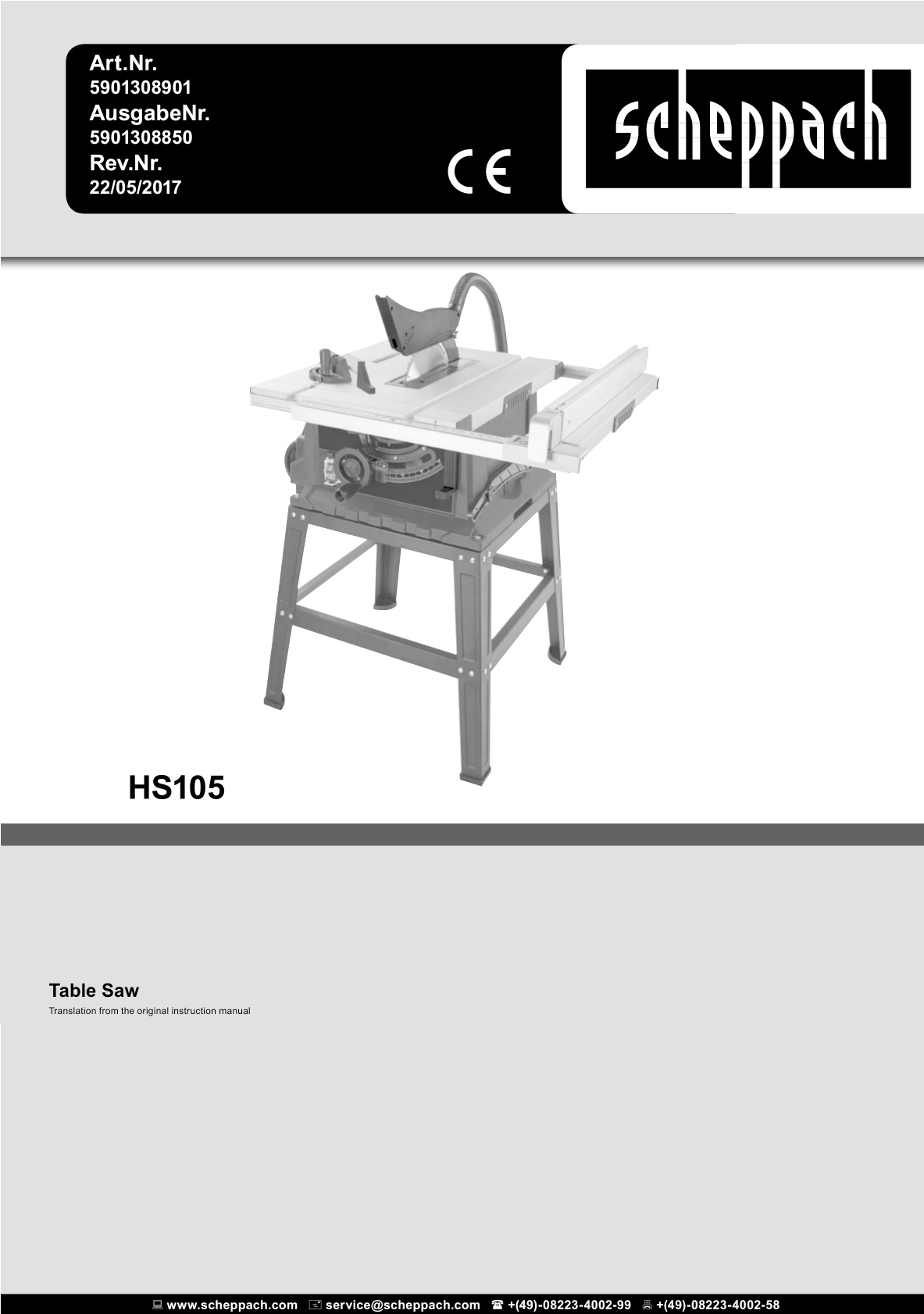
www.scheppach.com
service@scheppach.com
![]() Only for EU countries.
Only for EU countries.
Do not dispose of electric tools together with household waste material!
In observance of European directive 2012/19/EU on wasted electrical and electronic equipment and its implementation in accordance with national law, electric tools that have reached the end of their life must be collected separately and returned to an environmentally compatible recycling facility.
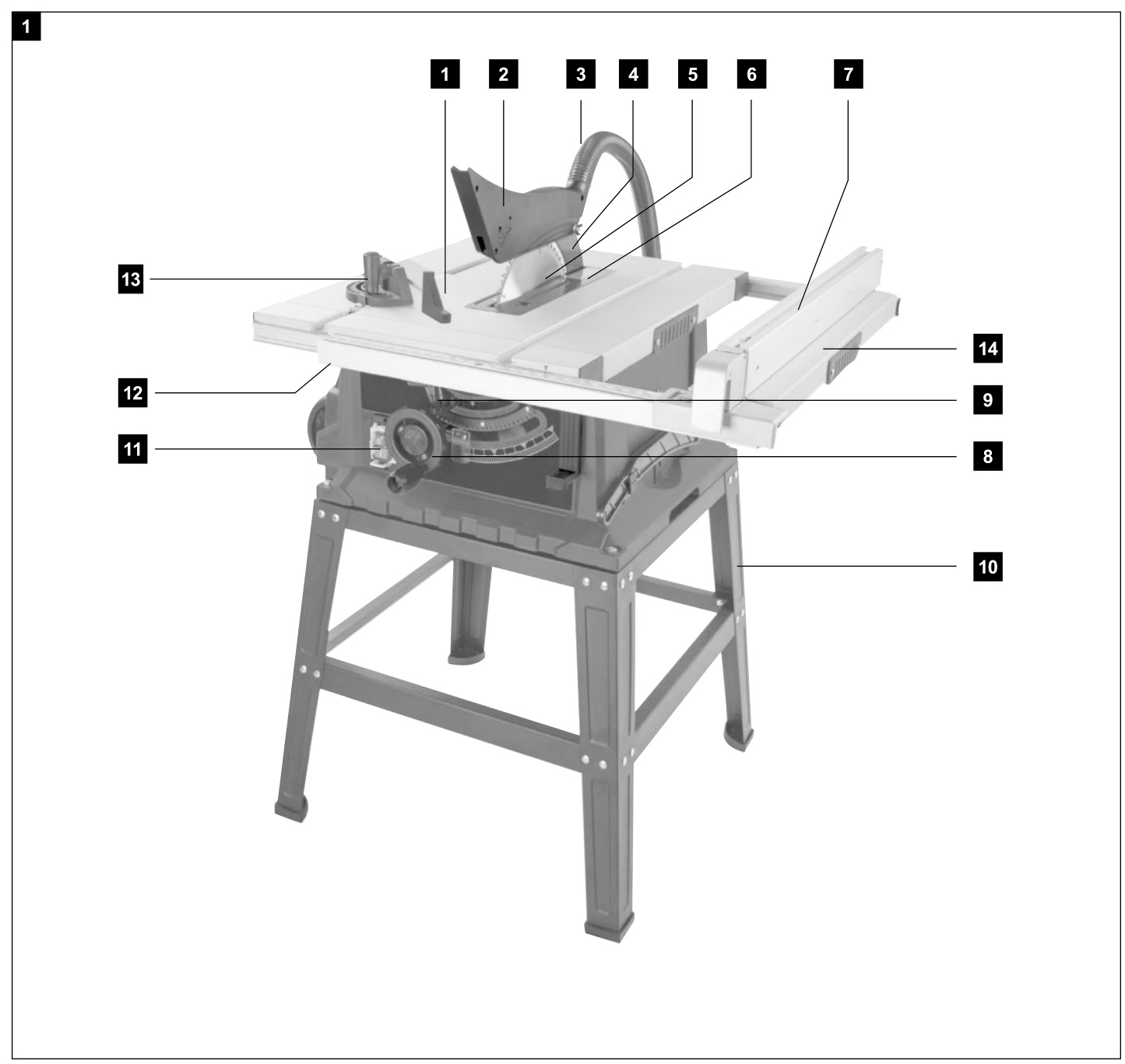
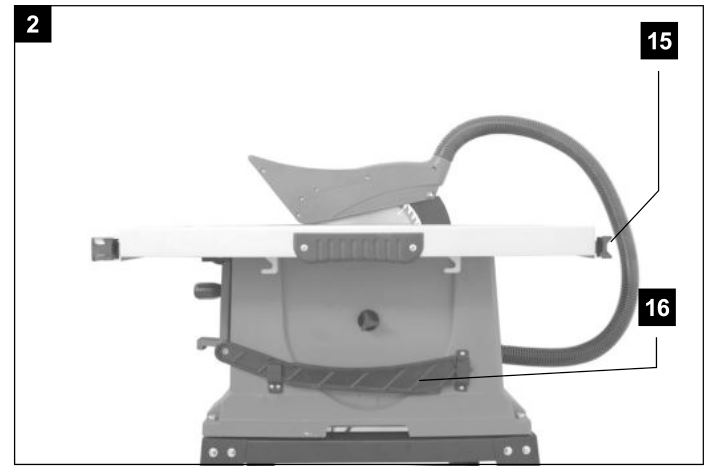
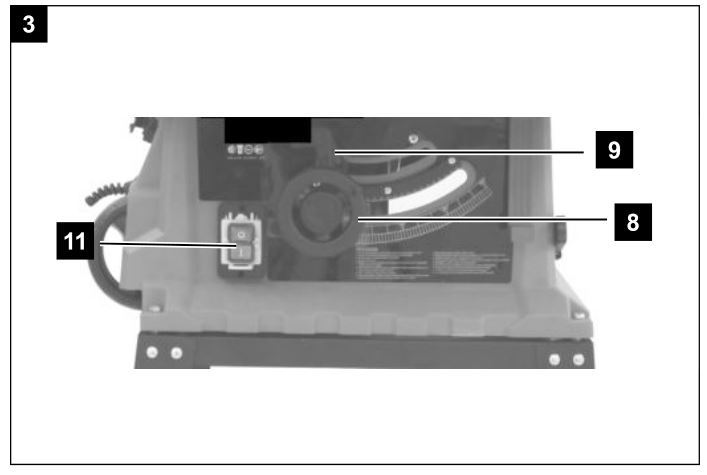
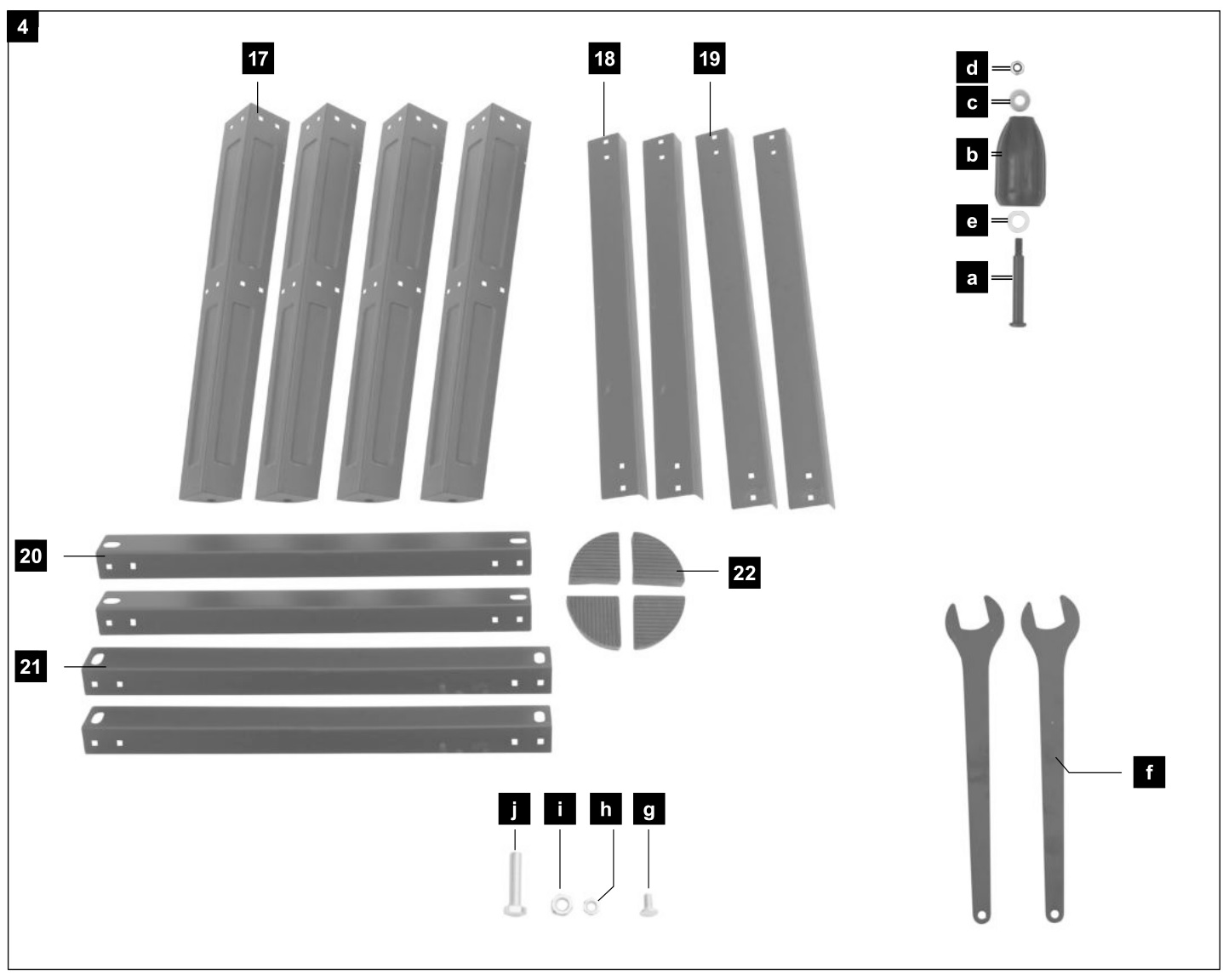

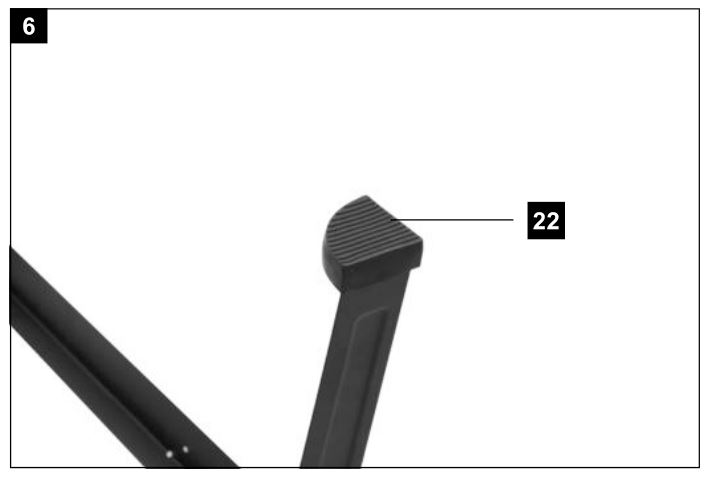
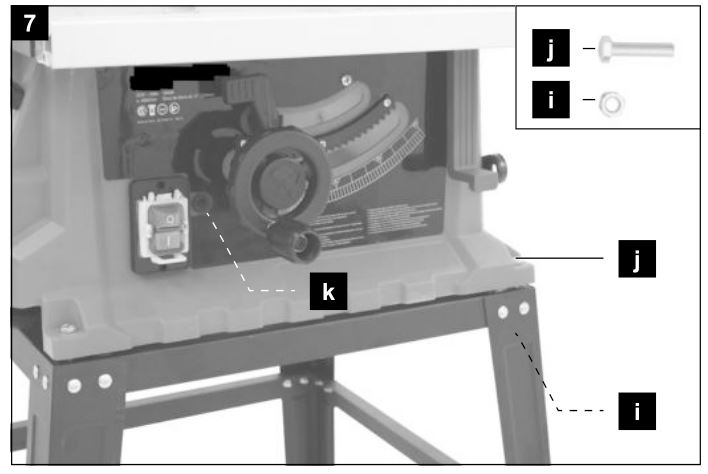
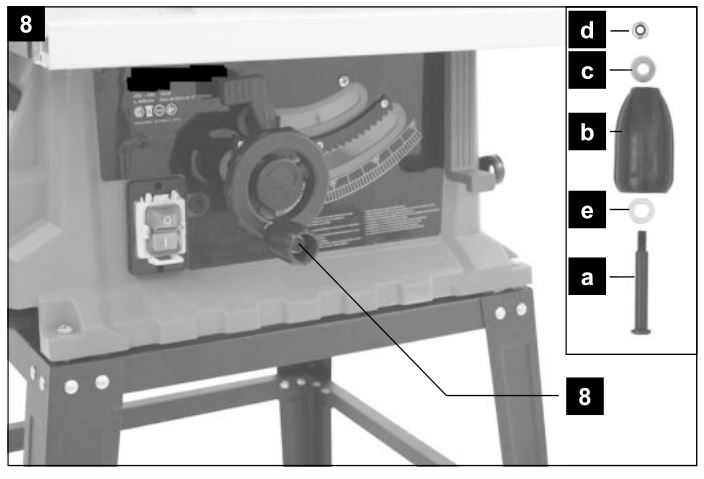

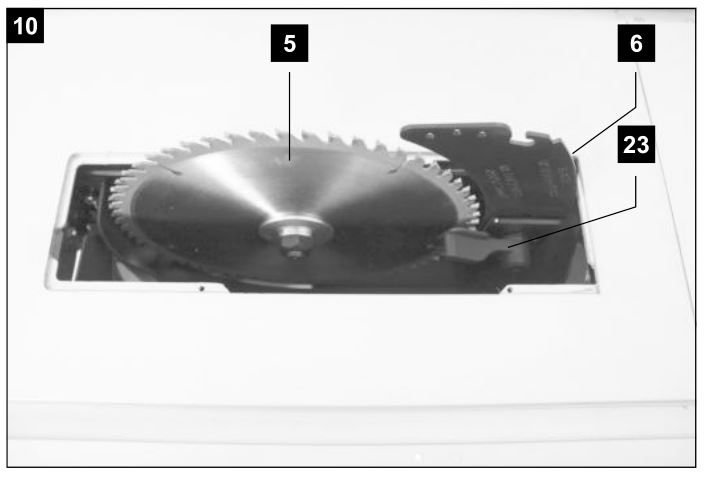
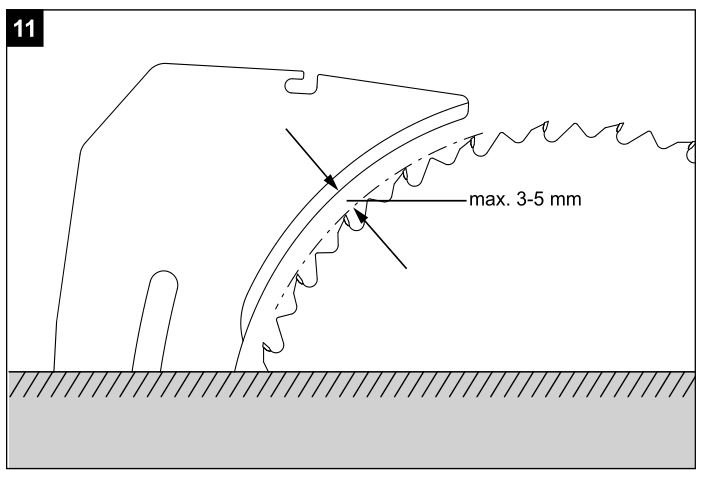

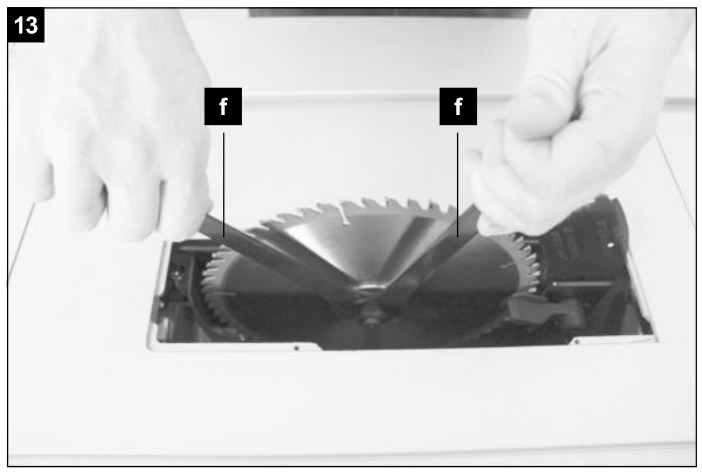
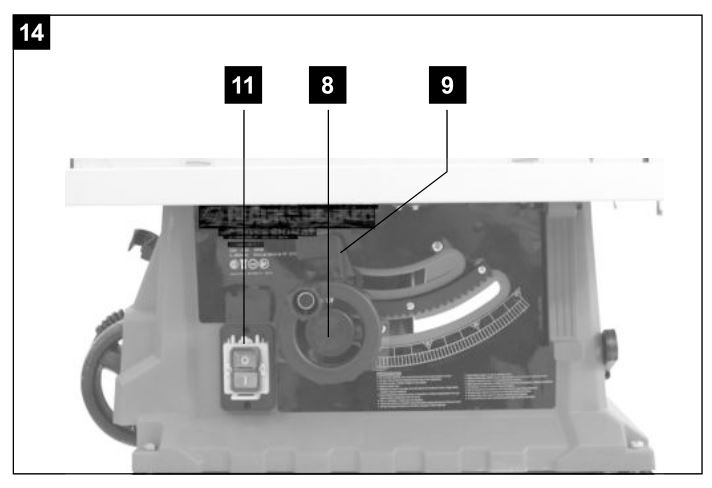
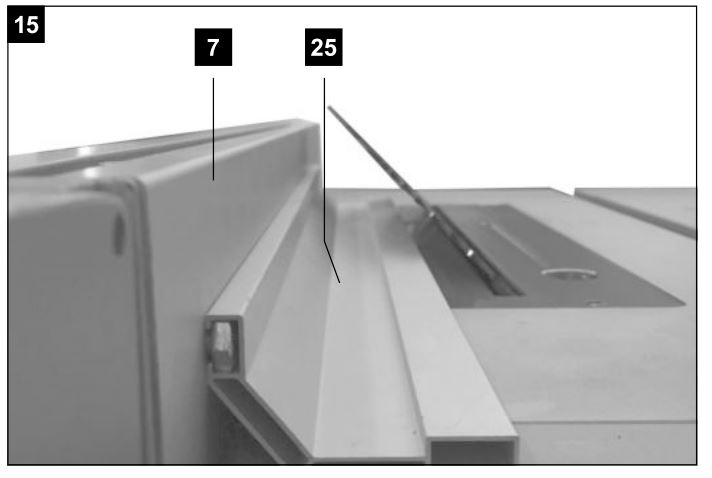
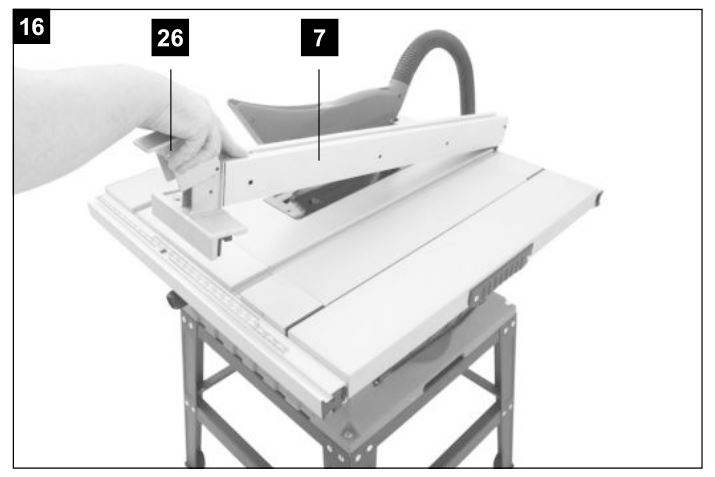


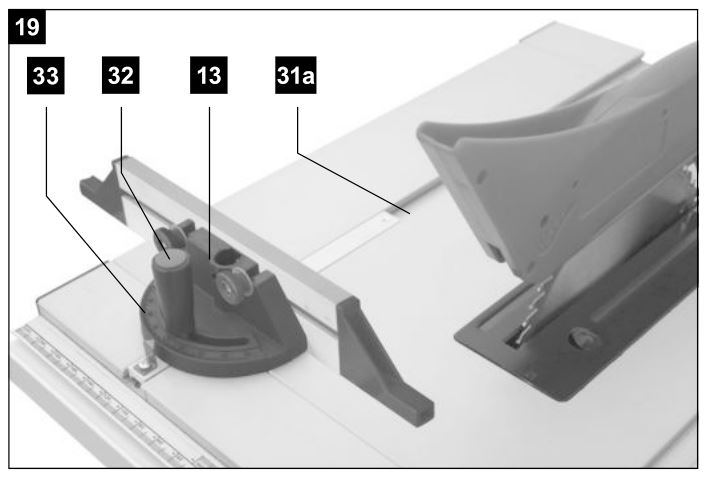
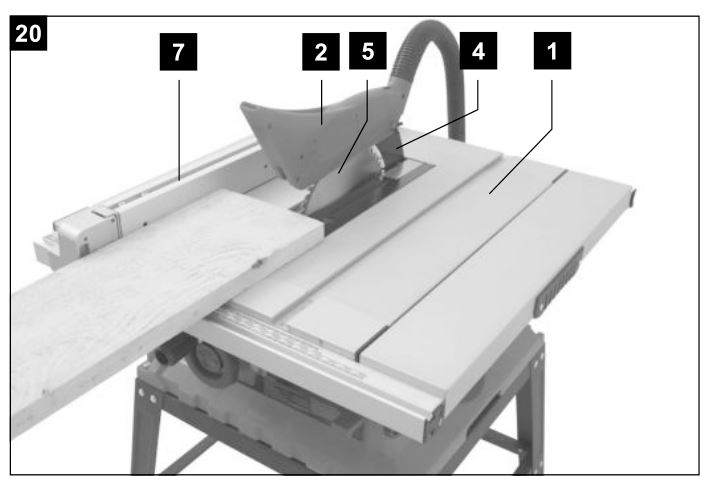
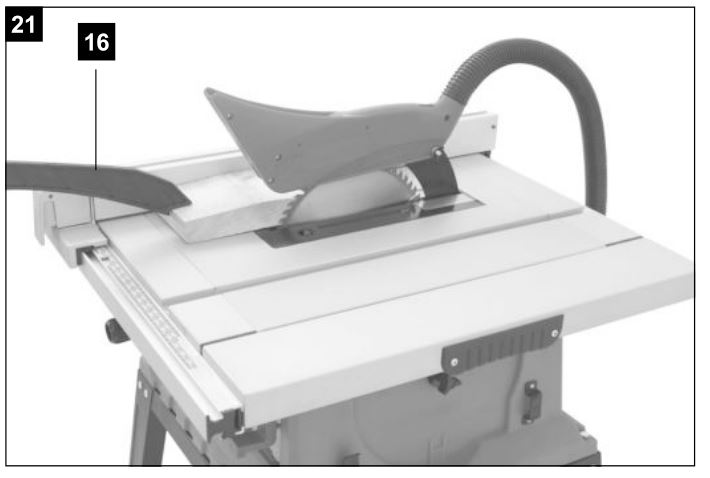
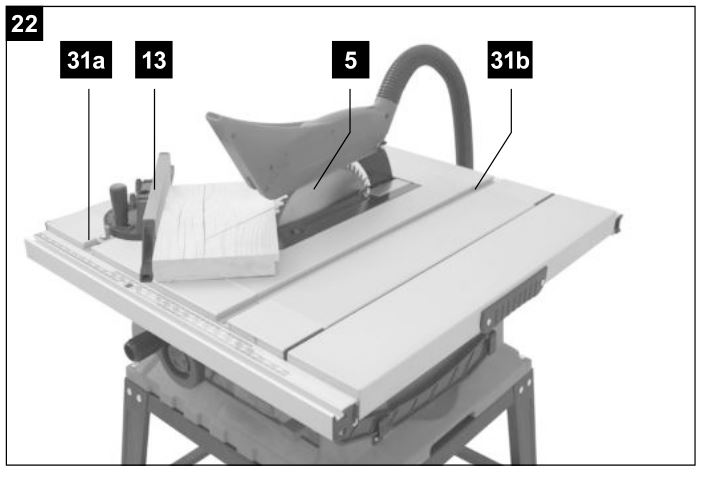
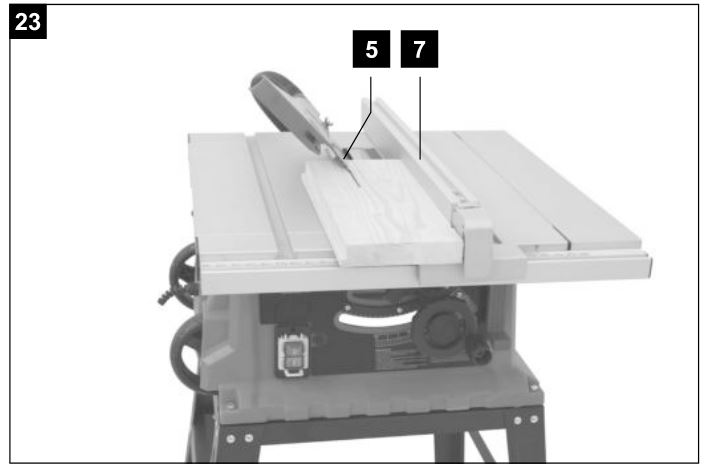
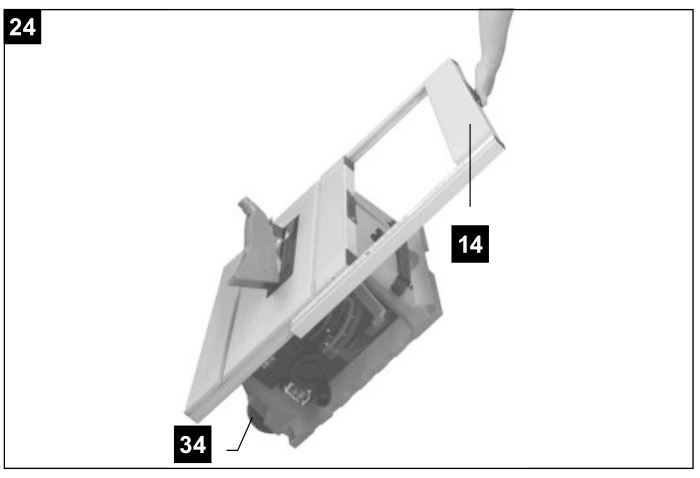
Explanation of the symbols on the equipment

Introduction
MANUFACTURER:
scheppach
Fabrikation von Holzbearbeitungsmaschine GmbH
Günzburger Straße 69
D-89335 Ichenhausen
DEAR CUSTOMER,
We hope your new tool brings you much enjoyment and success.
NOTE:
According to the applicable product liability laws, the manufacturer of the device does not assume liability for damages to the product or damages caused by the product that occurs due to:
- Improper handling,
- Non-compliance of the operating instructions,
- Repairs by third parties, not by authorized service technicians,
- Installation and replacement of non-original spare parts,
- Application other than specified,
- A breakdown of the electrical system that occurs due to the non-compliance of the electric regulations and VDE regulations 0100, DIN 57113 / VDE0113.
WE RECOMMEND:
Read through the complete text in the operating instructions before installing and commissioning the device. The operating instructions are intended to help the user to become familiar with the machine and take advantage of its application possibilities in accordance with the recommendations. The operating instructions contain important information on how to operate the machine safely, professionally and economically, how to avoid danger, costly repairs, reduce downtimes and how to increase reliability and service life of the machine. In addition to the safety regulations in the operating instructions, you have to meet the applicable regulations that apply for the operation of the machine in your country. Keep the operating instructions package with the machine at all times and store it in a plastic cover to protect it from dirt and moisture. Read the instruction manual each time before operating the machine and carefully follow its information. The machine can only be operated by persons who were instructed concerning the operation of the machine and who are informed about the associated dangers. The minimum age requirement must be complied with. In addition to the safety requirements in these operating instructions and your country’s applicable regulations, you should observe the generally recognized technical rules concerning the operation of woodworking machines.
Machine description (Fig. 1/2/3/4)
- Saw table
- Saw blade guard
- Extraction hose
- Riving knife
- Saw blade
- Table insert
- Rip fence
- Hand wheel
- Adjustment and locking handle
- Stand
- On/Off switch
- Guide rail
- Cross stop
- Table width extension
- Rear Guide rail
- Push stick
- Legs
- Cross struts
- Longitudinal struts
- Central struts, short
- Central struts, long
- Rubber feet
- Locking lever riving knife
- Stop rail
- Scale rip fence
- Scale table extension
Scope of delivery
- Open the packaging and remove the device carefully.
- Remove the packaging material as well as the packaging and transport bracing (if available).
- Check that the delivery is complete.
- Check the device and accessory parts for transport damage.
- If possible, store the packaging until the warranty period has expired.
ATTENTION
The device and packaging materials are not toys!
Children must not be allowed to play with plastic bags, film and small parts! There is a risk of swallowing and suffocation!
- Operating manual
- Saw with pre-installed saw blade
- Saw blade guard
- Extraction hose
- Riving knife
- Rip fence
- Fence rail
- Cross stop
- Table width extension (1x)
- Push stick
- Legs (4x)
- Cross struts (2x)
- Longitudinal struts (2x)
- Central struts, short (2x)
- Central struts, long (2x)
- Rubber feet (4x)
- Assembly material
Intended use
The bench-type circular saw is designed for the slitting and cross-cutting of all types of timber, commensurate with the machine’s size.
The machine is not to be used for cutting any type of roundwood.
The machine is to be used only for its prescribed purpose. Any use other than that mentioned is considered to be a case of misuse. The user/operator and not the manufacturer shall be liable for any damage or injury resulting such cases of misuse.
The machine is to be operated only with suitable saw blades. It is prohibited to use any type of cutting-off wheel. To use the machine properly you must also observe the safety regulations, the assembly instructions and the operating instructions to be found in this manual.
All persons who use and service the machine have to be acquainted with this manual and must be informed about its potential hazards. It is also imperative to observe the accident prevention regulations in force in your area. The same applies for the general rules of occupational health and safety.
![]() Important!
Important!
When using the equipment, a few safety precautions must be observed to avoid injuries and damage. Please read the complete operating instructions and safety regulations with due care. Keep this manual in a safe place, so that the information is available at all times. If you give the equipment to any other person, hand over these operating instructions and safety regulations as well. We cannot accept any liability for damage or accidents which arise due to a failure to follow these instructions and the safety instructions.
The manufacturer shall not be liable for any changes made to the machine nor for any damage resulting from such changes.
Even when the machine is used as prescribed it is still impossible to eliminate certain residual risk factors. The following hazards may arise in connection with the machine’s construction and design:
- Contact with the saw blade in the uncovered saw zone.
- Reaching into the running saw blade (cut injuries).
- Kick-back of workpieces and parts of workpieces
- Saw blade fracturing.
- Catapulting of faulty carbide tips from the saw blade.
- Damage to hearing if essential ear-muffs are not worn.
- Harmful emissions of wood dust when the machine is used in closed rooms.
![]() Please note that our equipment has not been designed for use in commercial, trade or industrial applications. Our warranty will be voided if the machine is used in commercial, trade or industrial businesses or for equivalent purposes.
Please note that our equipment has not been designed for use in commercial, trade or industrial applications. Our warranty will be voided if the machine is used in commercial, trade or industrial businesses or for equivalent purposes.
Safety information
![]() Attention! The following basic safety measures must be observed when using electric tools for protection against electric shock, and the risk of injury and fire. Read all these notices before using the electric tool and keep the safety instructions for later reference.
Attention! The following basic safety measures must be observed when using electric tools for protection against electric shock, and the risk of injury and fire. Read all these notices before using the electric tool and keep the safety instructions for later reference.
Safe work
- Keep the work area orderly
– Disorder in the work area can lead to accidents. - Take environmental influences into account
– Do not expose electric tools to rain.
– Do not use electric tools in a damp or wet environment.
– Make sure that the work area is well-illuminated.
– Do not use electric tools where there is a risk of fire or explosion. - Protect yourself from electric shock
– Avoid physical contact with earthed parts (e.g. pipes, radiators, electric ranges, cooling units). - Keep children away
– Do not allow other persons to touch the equipment or cable, keep them away from your work area. - Securely store unused electric tools
– Unused electric tools should be stored in a dry, elevated or closed location out of the reach of children. - Do not overload your electric tool
– They work better and more safely in the specified output range. - Use the correct electric tool
– Do not use low-output electric tools for heavy work.
– Do not use the electric tool for purposes for which it is not intended. For example, do not use handheld circular saws for the cutting of branches or logs.
– Do not use the electric tool to cut firewood. - Wear suitable clothing
– Do not wear wide clothing or jewellery, which can become entangled in moving parts.
– When working outdoors, anti-slip footwear is recommended.
– Tie long hair back in a hair net. - Use protective equipment
– Wear protective goggles.
– Wear a mask when carrying out dust-creating work. - Connect the dust extraction device if you will be processing wood, materials similar to wood, or plastics.
– If connections for dust extraction and a collecting device are present, make sure that they are connected and used properly.
– When processing wood, materials similar to wood, and plastics. operation in enclosed spaces is only permitted with the use of a suitable extraction system. - Secure the workpiece
– Use the clamping devices or a vice to hold the workpiece in place. In this manner, it is held more securely than with your hand.
– An additional support is necessary for long workpieces (table, trestle, etc.) in order to prevent the machine from tipping over.
– Always press the workpiece firmly against the working plate and stop in order to prevent bouncing and twisting of the workpiece. - Avoid abnormal posture
– Make sure that you have secure footing and always maintain your balance.
– Avoid awkward hand positions in which a sudden slip could cause one or both hands to come into contact with the saw blade. - Take care of your tools
– Keep cutting tools sharp and clean in order to be able to work better and more safely.
– Follow the instructions for lubrication and for tool replacement.
– Check the connection cable of the electric tool regularly and have it replaced by a recognised specialist when damaged.
– Check extension cables regularly and replace them when damaged.
– Keep the handle dry, clean and free of oil and grease. - Pull the plug out of the outlet
– Never remove loose splinters, chips or jammed wood pieces from the running saw blade.
– During non-use of the electric tool or prior to maintenance and when replacing tools such as saw blades, bits, milling heads.
– When the saw blade is blocked due to abnormal feed force during cutting, turn the machine off and disconnect it from power supply. Remove the work piece and ensure that the saw blade runs free. Turn the machine on and start new cutting operation with reduced feed force. - Do not leave a tool key inserted
– Before switching on, make sure that keys and adjusting tools are removed. - Avoid inadvertent starting
– Make sure that the switch is switched off when plugging the plug into an outlet. - Use extension cables for outdoors
– Only use approved and appropriately identified extension cables for use outdoors.
– Only use cable reels in the unrolled state. - Remain attentive
– Pay attention to what you are doing. Remain sensible when working. Do not use the electric tool when you are distracted. - Check the electric tool for potential damage
– Protective devices and other parts must be carefully inspected to ensure that they are fault-free and function as intended prior to continued use of the electric tool.
– Check whether the moving parts function faultlessly and do not jam or whether parts are damaged. All parts must be correctly mounted and all conditions must be fulfilled to ensure fault-free operation of the electric tool.
– The moving protective hood may not be fixed in the open position.
– Damaged protective devices and parts must be properly repaired or replaced by a recognised workshop, insofar as nothing different is specified in the operating manual.
– Damaged switches must be replaced at a customer service workshop.
– Do not use any faulty or damaged connection cables.
– Do not use any electric tool on which the switch cannot be switched on and off. - ATTENTION!
– Exercise elevated caution for double mitre cuts. - ATTENTION!
– The use of other insertion tools and other accessories can entail a risk of injury. - Have your electric tool repaired by a qualified electrician
– This electric tool conforms to the applicable safety regulations. Repairs may only be performed by an electrician using original spare parts. Otherwise accidents can occur. - Do not use the cable for purposes for which it is not intended
– Do not use the cable to pull the plug out of the outlet. Protect the cable from heat, oil and sharp edges.
ADDITIONAL SAFETY INSTRUCTIONS
- Safety precautions
– Warning! Do not use damaged, cracked or deformed saw blades.
– Replace a worn table insert.
– Only use saw blades recommended by the manufacturer which conform to EN 847-1.
 Warning! Keep attention When changing the saw blade. The cutting width is not smaller and the main blade thickness of the saw blade is not greater than the thickness of the gap wedge!
Warning! Keep attention When changing the saw blade. The cutting width is not smaller and the main blade thickness of the saw blade is not greater than the thickness of the gap wedge!
– Make sure that a suitable saw blade for the material to be cut is selected.
– Wear suitable personal protective equipment. This includes:
Hearing protection to avoid the risk of becoming hearing impaired, Respiratory protection to avoid the risk of inhaling harmful dust,
– Wear gloves when handling saw blades and rough materials.
– Carry saw blades in a container whenever practical.
– Wear goggles. Sparks generated during work or splinters, chippings and dust coming from the device can lead to loss of eyesight.
– Connect a dust collecting device to the electric tool when sawing wood. The emission of dust is influenced, among other things, by the type of material to be processed, the significance of local separation (collection or source) and the correct setting of the hood/guide plates/guides.
– Do not use saw blades made of high-speed alloy steel (HSS steel).
– In times of non-use keep the push stick or the push block with the electrical power tool in its holder at all times. - Maintenance and repair
– Pull out the mains plug for any adjustment or repair tasks.
– The generation of noise is influenced by various factors, including the characteristics of saw blades, condition of saw blade and electric tool. Use saw blades which were designed for reduced noise development, insofar as possible. Maintain the electric tool and tool attachments regularly and if necessary, initiate repairs in order to reduce noise.
– Report faults on the electric tool, protective devices or the tool attachment to the person responsible for safety as soon as they are discovered. - Safe work
– Use the push stick or handle with sliding wood, to pass the workpiece securely out off the saw blade.
– Make sure that the riving knife is always used, and set up is correctly.
– Use the upper blade guard and set it to the correct position.
– Only use saw blades for which the maximum permissible speed is not lower than the maximum spindle speed of table saws and which are suitable for the material to be cut.
– Do not cut rebates or grooves without fitting a suitable guard, e.g. a tunnel-type guard, over the saw table.
– Circular saws must not be used for slotting jobs (cutting grooves which end in the workpiece).
– When transporting the electric tool, only use the transport devices. Never use the protective devices for handling or transport.
– Make sure that the upper part of the saw blade is covered during transport, e.g. by the protective device.
– Be sure to only use spacers and spindle rings specified by the manufacturer as suitable for the intended purpose.
– The floor around the machine must be level, clean and free of loose particles, such as chips and cutting residues.
– Always stand to the side of the saw blade when working with the saw.
– Do not remove any cutting residues or other parts of workpieces from the cutting zone while the machine is running and the saw unit is not at rest.
– Make sure that the machine is always secured on a workbench or a table if at all possible.
– Support long workpieces (e.g. with a roller table) to prevent them sagging at the end of a cut.
– Attention! Never remove loose splinters, chips or jammed pieces of wood while the saw blade is running.
Attention! Never remove loose splinters, chips or jammed pieces of wood while the saw blade is running.
• Switch off the machine to troubleshoot or remove jammed pieces of wood. – Disconnect the main power plug –
• Refitting, including adjusting and measuring works, and cleaning must be carried out only when the motor is switched off. – Disconnect the main power plug –
• Before switching on again, ensure that keys and adjustment tools have been removed.
Warning! This electric tool generates an electromagnetic field during operation. This field can impair active or passive medical implants under certain conditions. In order to prevent the risk of serious or deadly injuries, we recommend that persons with medical implants consult with their physician and the manufacturer of the medical implant prior to operating the electric tool.
SAFETY INSTRUCTIONS FOR THE HANDLING OF SAW BLADES
- Only use insertion tools if you have mastered their use.
- Observe the maximum speed. The maximum speed specified on the insertion tool may not be exceeded.
If specified, observe the speed range. - Observe the motor / saw blade direction of rotation.
- Do not use any insertion tools with cracks. Sort out cracked insertion tools. Repairs are not permitted.
- Clean grease, oil and water off of the clamping surfaces.
- Do not use any loose reducing rings or bushes for the reducing of holes on saw blades.
- Make sure that fixed reducer rings for securing the insertion tool have the same diameter and have at least 1/3 of the cutting diameter.
- Make sure that fixed reducer rings are parallel to each other.
- Handle insertion tool with caution. They are ideally stored in the originally package or special containers.
Wear protective gloves in order to improve grip and to further reduce the risk of injury. - Prior to the use of insertion tools, make sure that all protective devices are properly fastened.
- Prior to use, make sure that the insertion tool meets the technical requirements of this electric tool and is properly fastened.
- Only use the supplied saw blade for sawing operations in wood, materials similar to wood, plastics and non-ferrous metals (except for magnesium and alloys containing magnesium).
Residual risks
The machine has been built according to the state of the art and the recognised technical safety requirements. However, individual residual risks can arise during operation.
- Health hazard due to electrical power, with the use of improper electrical connection cables.
- Furthermore, despite all precautions having been met, some non-obvious residual risks may still remain.
- Residual risks can be minimised if the „safety instructions“ and the „Proper use“ are observed along with the whole of the operating instructions.
- Do not load the machine unnecessarily: excessive pressure when sawing will quickly damage the saw blade, which results in reduced output of the machine in the processing and in cut precision.
- When cutting plastic material, please always use clamps: the parts which should be cut must always be fixed between the clamps.
- Avoid accidental starting of the machine: the operating button may not be pressed when inserting the plug in an outlet.
- Use the tool that is recommended in this manual. In doing so, your saw provides optimal performance.
- Hands may never enter the processing zone when the machine is in operation. Release the handle button and switch off the machine prior to any operations.
- Prior to any adjustment, maintenance or service work disconnect the mains power plug!
Technical data
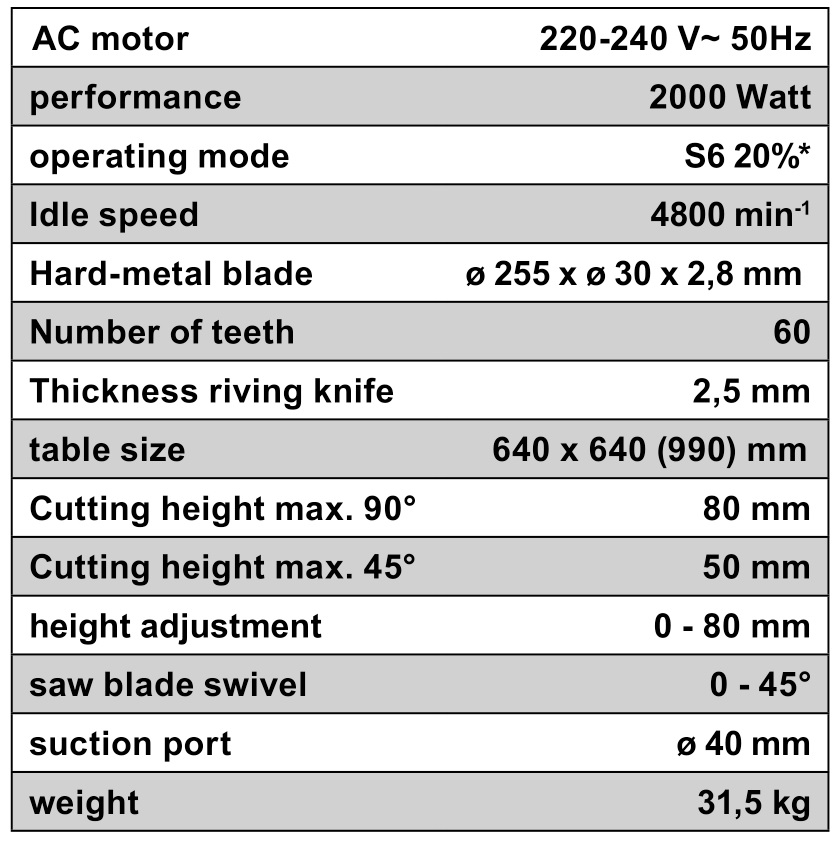
* operating mode S6 20%: Continuous operation with intermittent loading (playing time 10 min). Engine protection of to hot warming up: It´s allowed to run the engine with nominal power maximum 20% of playing time. After this the machine must run 80% of playing time steadily without load.
Noise values
The total noise values determined in accordance with EN 61029.

Wear hearing protection.
The effects of noise can cause a loss of hearing. Total vibration values (vector sum – three directions) determined in accordance with EN 61029.
Before starting the equipment
- The equipment must be set up where it can stand securely, i.e. it should be bolted to a workbench, a universal base frame or similar.
- All covers and safety devices have to be properly fitted before the equipment is switched on.
- It must be possible for the blade to run freely.
- When working with wood that has been processed before, watch out for foreign bodies such as nails or screws, etc.
- Before you press the ON/OFF switch check that the saw blade is fitted correctly. Moving parts must run smoothly.
- Before you connect the equipment to the power supply make sure the data on the rating plate are dentical to the mains data.
- Connect the machine to a properly installed protective contact socket, with at least 16A circuit breaker.
Attachment
Important. Pull out the power plug before carrying out any maintenance, resetting or assembly work on the circular saw!
Place all parts supplied on a flat surface. Grouping equal parts.
Note: If compounds with a bolt (round head / or hexagon), hex nuts and washers are backed up, the washer must be fitted under the nut.
Insert screws each from outside to inside. Secure connections with nuts on the inside.
Note: Tighten the nuts and bolts during assembly only to the extent that they can not fall down.
If you tighten the nuts and bolts prior to final assembly, final assembly can not be performed.
8.1 Frame assembly, Fig. 5/6/7
- Fix the four legs (17) with the bolts (g) and nuts (h) to the struts (20+21).
 Warning!
Warning!
The top struts are equipped with a slot for fixing them to the table!
Ensure that markings A and B are always opposite each other. - Now loosely fix the lower struts to the legs using the bolts (g) and nuts (h) (Fig. 5).
- Now place the rubber feet (22) on the legs (Fig. 6).
- Then mount the entire saw on the frame by fixing the hexagon head bolts and the nuts in the corners (Fig. 7).
- Afterwards, tighten all bolts and nuts to the frame.
8.2 Hand wheel assembly, Fig. 8
- Place the washer (e) on the bolt (a).
- Then place the bolt on the handle (b) and the washer (c) on the bolt.
- Fix the whole assembly to the hand wheel (8) and secure it with the hex-nut (d).
8.3 Riving knife set-up (Fig. 9/10/11)
![]() Warning! Disconnect the mains cable!
Warning! Disconnect the mains cable!
The set-up of the riving knife (6) must be checked before each use.
- Set the saw blade (5) to the max. cutting depth, put it in the 0° position and lock it. .
- Remove the table insert (6) (Fig. 9)
 Warning! For transport reasons, the riving knife (6) was fixed in the lower position before initial commissioning. Only work with the machine if the riving knife (6) is in the upper position. Fitting the riving knife (6) in the upper position is as follows:
Warning! For transport reasons, the riving knife (6) was fixed in the lower position before initial commissioning. Only work with the machine if the riving knife (6) is in the upper position. Fitting the riving knife (6) in the upper position is as follows: - Loosen the locking handle (23) and push the riving knife (6) in the upper position (Fig. 10).
- The gap between the saw blade (5) and the riving knife (6) should be a maximum of 5 mm (Fig. 11).
- Re-tighten the mounting screw (23) and fix the table insert (6).
8.4 Saw blade guard assembly (Fig. 12)
- Place the saw blade guard (2) including the bolt (24) on the riving knife (4) from above so that the bolt is tight in the slot of the riving knife (4).
- Do not tighten the bolt (24) too much; the saw blade guard (2) must be able to move freely.
- Place the extraction hose (3) on the extraction adapter on the rear of the machine and on the extraction nozzle of the saw blade guard (2).
- Disassembly takes place in reverse order.
Warning!
Before starting to saw, lower the saw blade guard (2) on to the work piece.
8.5 Saw blade assembly/replacement (Fig. 9/12/13)
- Warning! Disconnect the mains supply and wear safety gloves.
- Disassemble the saw blade guard (2) (Fig. 12).
- Remove the table insert (6) (Fig. 9).
- Loosen the nut by placing the open-ended spanner (f) on the nut and countering with another open-ended spanner (f) on the flange (Fig. 13).
- Warning! Turn the nut in the rotational direction of the saw blade.
- Remove the outer flange and pull the old saw blade from the inner flange, with a diagonally downwards movement.
- Carefully clean the saw blade flange with a wire brush before fixing the new saw blade.
- Insert the new saw blade in reverse order and tighten it.
Warning! Observe the rotational direction; the teeth have to point in the direction of rotation, i.e. forwards. - Attach the table insert (6) and the saw blade guard (2) again and set them.
- Before working with the saw again, check the functionality of the guards.
Using the saw
9.1 On/Off switch (Fig. 14)
– The saw can be switched on by pressing the green pushbutton (11) „I“.
– The red pushbutton (11) „0“ has to be pressed to switch off the saw.
9.2 Cutting depth (Fig. 14)
Turn the round handle (8) to set the blade to the required cutting depth.
– Turn anti-clockwise: larger cutting depth
– Turn clockwise: smaller cutting depth
After each new adjustment it is advisable to carry out a trial cut in order to check the set dimensions.
9.3 Setting the angle (Fig. 14)
With the table saw you can make diagonal cuts to the left oriented to the stop bar from 0 ° to 45 °.
![]() Check before each cut, that between the stop bar (e), cross-stop (13) and the saw blade (5) a collision is not possible.
Check before each cut, that between the stop bar (e), cross-stop (13) and the saw blade (5) a collision is not possible.
– Loose the fixing handle (9).
– Set the required angle on the scale.
– Lock the fixing handle (9) again in the required angle position.
9.4 Working with the rip fence
9.4.1 Setting the fence height (Fig. 15)
– The fence rail (25) of the rip fence (7) has two guiding surfaces with different heights.
– Depending on the thickness of the material to be cut, the higher side of the fence rail (25) has to be used for thick material (work piece thickness above 25 mm) and the lower side of the fence rail for thin material (work piece thickness below 25 mm).
– For the adjustment, loosen the bolts on the side of the rip fence (7) and push the fence rail (25) on the guide, depending on the required position.
– Tighten the bolts again.
9.4.2 Rip fence assembly (Fig. 16)
– Fix the rip fence (7) by placing it at the back and pulling the locking lever (23) down.
– For disassembly, pull the locking lever up and remove the rip fence (7).
– The locking force of the rip fence can be set with the rear knurled nut.
9.4.3 Setting the cutting width (Fig. 17)
– The rip fence (7) must be used for lengthwise cutting of wood.
– Place the rip fence (7) on the guide rail (12) to the right or left of the saw blade.
– On the guide rail for the rip fence (12) there are 2 scales (27/28) which display the gap between the fence rail (25) and the saw blade (5).
– Set the rip fence (7) to the required specification on the sight-glass (29) and secure it with the locking handle for the rip fence.
9.5 Using the table width extension (Fig. 18)
– The table width extension (14) should always be used for particularly wide work pieces.
– Loosen the locking handle (30) and pull out the table width extension enough so the work piece can lie on it without tilting.
9.6 Cross stop (Fig. 19)
– Push the cross stop (13) into a slot (31 a/b) on the saw table.
– Loosen the locking handle (32).
– Rotate the cross stop (13) until the required angle is set. The scale (33) shows the set angle.
– Re-tighten the locking handle (33).
Operation
Working instructions
After each new adjustment it is advisable to carry out a trial cut in order to check the set dimensions. After switching on the saw, wait for the blade to reach its maximum speed of rotation before commencing with the cut.
Secure long workpieces against falling off at the end of the cut (e.g. with a roller stand etc.)
Take extra care when starting the cut!
Never use the equipment without the suction function.
Regularly check and clean the suction channels.
10.1 Making longitudinal cuts (Figure 20)
Longitudinal cutting (also known as slitting) is when you use the saw to cut along the grain of the wood.
Press one edge of the workpiece against the parallel stop (7) while the flat side lies on the saw table (1). The blade guard (2) must always be lowered over the workpiece.
When you make a longitudinal cut, never adopt a working position that is in line with the cutting direction.
– Set the parallel stop (7) in accordance with the workpiece height and the desired width. (See 9.4)
– Switch on the saw.
– Place your hands (with fingers closed) flat on the workpiece and push the workpiece along the parallel stop (7) and into the blade (5).
– Guide at the side with your left or right hand (depending on the position of the parallel stop) only as far as the front edge of the saw blade guard (2).
– Always push the workpiece through to the end of the splitter (4).
– The offcut piece remains on the saw table (1) until the blade (5) is back in its position of rest.
– Secure long workpieces against falling off at the end of the cut (e.g. with a roller stand etc.) (e.g. roller table etc.)
10.1.1 Cutting narrow workpieces (Fig. 21)
Be sure to use a push stick (16) when making longitudinal cuts in work pieces smaller than 120 mm in width. A push block is supplied with the saw! Replace a worn or damaged push stick immediately.
- Adjust the parallel stop to the width of work piece you require. (see 9.4)
- Feed in the work piece with two hands. Always use the push stick (16) in the area of the saw blade.
- Always push the work piece through to the end of the splitter.
![]() Caution! With short work pieces, use the push stick from the beginning.
Caution! With short work pieces, use the push stick from the beginning.
10.2 Making cross cuts (Fig. 22)
– Slide the cross stop (13) into one of the grooves (32a/32b) in the table and adjust to the required angle. (see 9.6). If you also want to tilt the blade (5), use the groove (31a) which prevents your hand and the cross stop from making contact with the blade guard.
– Press the work piece firmly against the cross stop (13).
– Switch on the saw.
– Push the cross stop (13) and the work piece toward the blade in order to make the cut.
– Important:
Always hold the guided part of the work piece. Never hold the part which is to be cut off.
– Push the cross stop (13) forward until the work piece is cut all the way through.
– Switch off the saw again. Do not remove the off cut until the blade has stopped rotating.
10.2.1 Making angular cuts (Fig.22)
Angular cuts must always be made using the parallel stop (7).
– Set the blade (5) to the desired angle. (See 9.3)
– Set the parallel stop (7) in accordance with the work piece width and height (see 9.4)
– Carry out the cut in accordance with the work piece width (see 10.1).
10.3 Cutting particle boards
To prevent the cutting edges from cracking when working with particle boards, you should not set the saw blade (5) more than 5mm greater than the thickness of the workpiece (also see 9.2).
Transport
- Before any transport, turn the power tool off and disconnect it from the power supply.
- At least two people are needed to carry the power tool.
- Protect the power tool from blows, impact and strong vibrations, e.g. during transport in vehicles.
- Secure the power tool against tilting and sliding.
- Never use guards for handling or transport.
11.1 Transport without frame (Fig. 24)
- Pull out the table width extension (14).
- Tilt the machine to its wheels (32).
- Hold on to the machine by the handle on the table width extension (14) and pull it behind you.
Maintenance
![]() Warning! Prior to any adjustment, maintenance or service work disconnect the mains power plug!
Warning! Prior to any adjustment, maintenance or service work disconnect the mains power plug!
12.1 General maintenance measures
- Keep all safety devices, air vents and the motor housing free of dirt and dust as far as possible. Wipe the equipment with a clean cloth or blow it down with compressed air at low pressure.
- We recommend that you clean the equipment immediately after you use it.
- Clean the equipment regularly with a damp cloth and some soft soap. Do not use cleaning agents or solvents; these may be aggressive to the plastic parts in the equipment. Ensure that no water can get into the interior of the equipment.
- In order to extend the service life of the tool, oil the rotary parts once monthly. Do not oil the motor.
12.2 Brush inspection
In case of excessive sparking, have the carbon brushes checked only by a qualified electrician. Important. The carbon brushes should not be replaced by anyone but a qualified electrician.
Storage
Store the device and its accessories in a dark, dry and frost-proof place that is inaccessible to children. The optimum storage temperature is between 5 and 30˚C.
Store the electrical tool in its original packaging.
Cover the electrical tool in order to protect it from dust and moisture.
Store the operating manual with the electrical tool.
Electrical connection
The electrical motor installed is connected and ready for operation. The connection complies with the applicable VDE and DIN provisions.
The customer‘s mains connection as well as the extension cable used must also comply with these regulations.
- The product meets the requirements of EN 61000-3-11 and is subject to special connection conditions. This means that use of the product at any freely selectable connection point is not allowed.
- Given unfavorable conditions in the power supply the product can cause the voltage to fluctuate temporarily.
- The product is exclusively intended for use at connection points that have a continuous current-carrying capacity of at least 100 Amper phase.
- As the user, you are required to ensure, in consultation with your electric power company if necessary, that the connection point at which you wish to operate the product meets the specified requirements.
Important information
In the event of an overloading the motor will switch itself off. After a cool-down period (time varies) the motor can be switched back on again.
Damaged electrical connection cable
The insulation on electrical connection cables is often damaged.
This may have the following causes:
- Passage points, where connection cables are passed through windows or doors.
- Kinks where the connection cable has been improperly fastened or routed.
- Places where the connection cables have been cut due to being driven over.
- Insulation damage due to being ripped out of the wall outlet.
- Cracks due to the insulation ageing.
Such damaged electrical connection cables must not be used and are life-threatening due to the insulation damage.
Check the electrical connection cables for damage regularly. Make sure that the connection cable does not hang on the power network during the inspection.
Electrical connection cables must comply with the applicable VDE and DIN provisions. Only use connection cables with the marking „H05VV-F“.
The printing of the type designation on the connection cable is mandatory.
AC motor
- AC motor
- The mains voltage must be 220 – 240 V~
- Extension cables up to 25 m long must have a cross-section of 1.5 mm2.
Connections and repairs of electrical equipment may only be carried out by an electrician.
Please provide the following information in the event of any enquiries:
Type of current for the motor - Machine data – type plate
- Machine data – type plate
![]() OVERLOAD PROTECTION (FIG.7)
OVERLOAD PROTECTION (FIG.7)
- This electrical power tool is provided with an overload protection. In case that the overload protection was initiated, proceed as follows:
- Disconnect the power tool from the power supply.
- Allow the power tool to cool down.
- Check the power tool carefully for possible damages.
- Have damages repaired before re-starting the power tool.
- Connect the power tool to the power supply.
- Push the overload switch (k).
- Turn on the power tool as described and put it into operation.
Troubleshooting

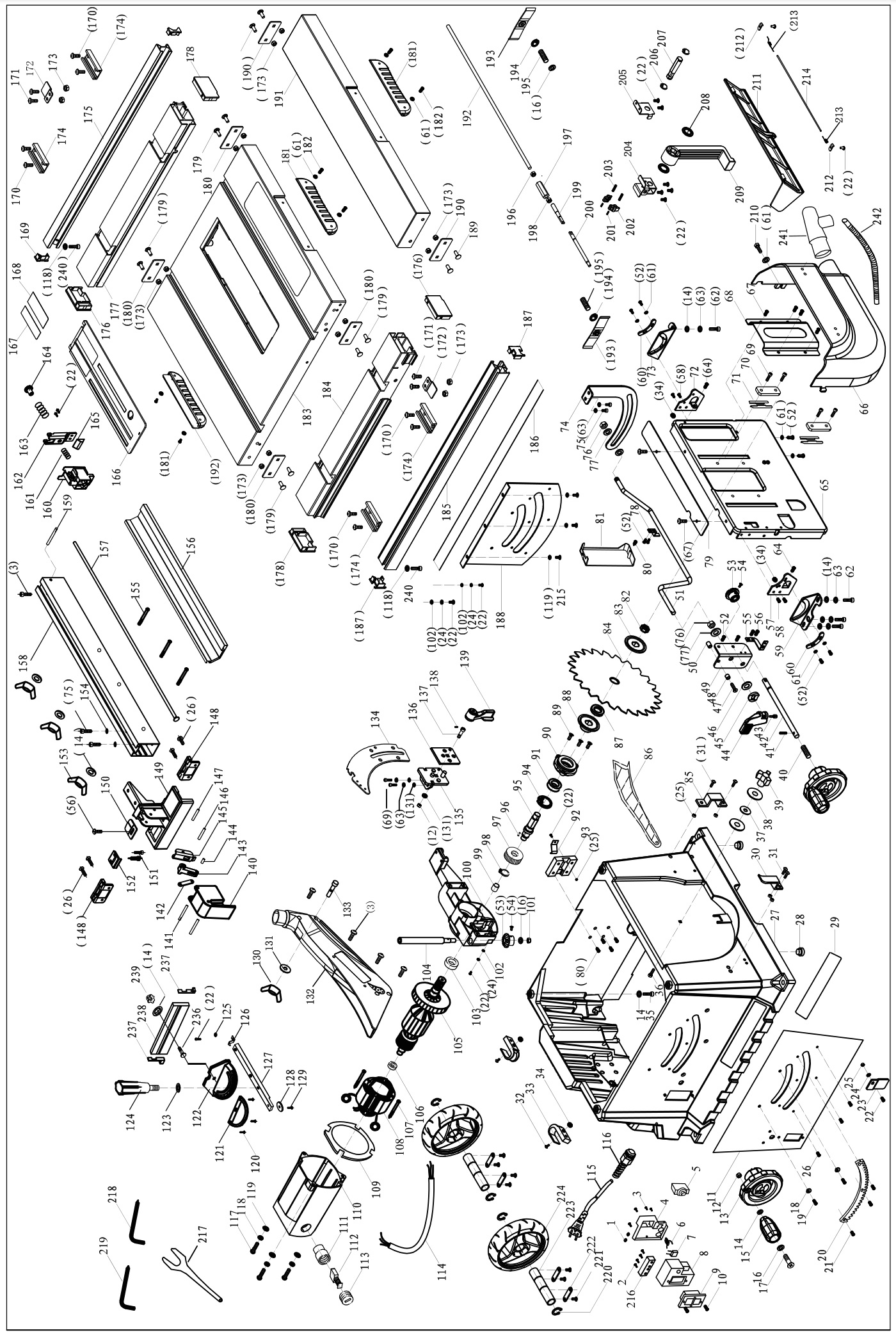

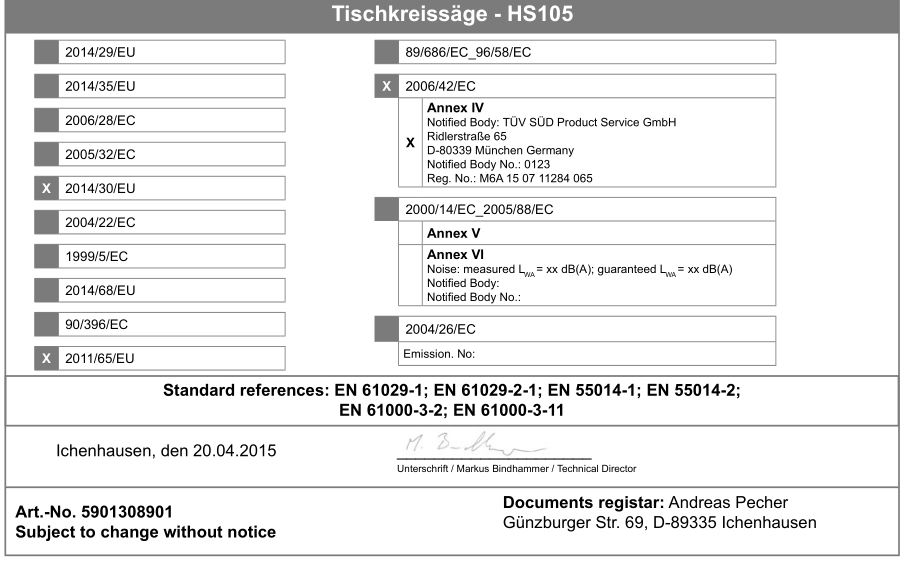
Warranty
Apparent defects must be notified within 8 days from the receipt of the goods. Otherwise, the buyerís rights of claim due to such defects are invalidated. We guarantee for our machines in case of proper treatment for the time of the statutory warranty period from delivery in such a way that we replace any machine part free of charge which provably becomes unusable due to faulty material or defects of fabrication within such period of time. With respect to parts not manufactured by us we only warrant insofar as we are entitled to warranty claims against the upstream suppliers. The costs for the installation of the new parts shall be borne by the buyer. The cancellation of sale or the reduction of purchase price as well as any other claims for damages shall be excluded.
scheppach Fabrikation von Holzbearbeitungsmaschinen GmbH | Günzburger Str. 69 |
D-89335 Ichenhausen | www.scheppach.com
![]() +(49)-08223-4002-99
+(49)-08223-4002-99
![]() +(49)-08223-4002-58
+(49)-08223-4002-58
